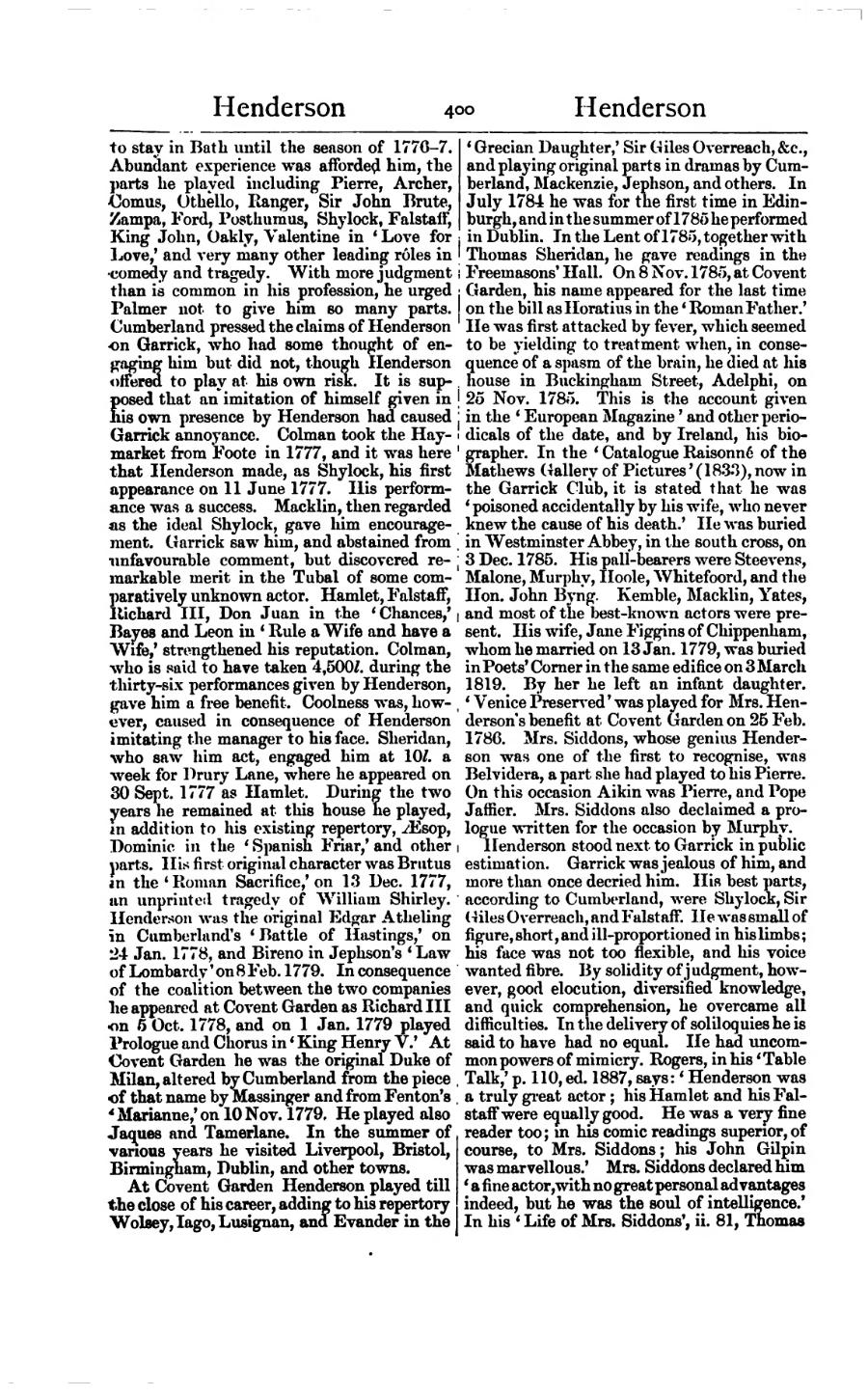to stay in Bath until the season of 1776–7. Abundant experience was afforded him, the parts he played including Pierre, Archer, Comus, Othello, Ranger, Sir John Brute, Zampa, Ford, Posthumus, Shylock, Falstaff, King John, Oakly, Valentine in ‘Love for Love,’ and very many other leading rôles in comedy and tragedy. With more judgment than is common in his profession, he urged Palmer not to give him so many parts. Cumberland pressed the claims of Henderson on Garrick, who had some thought of engaging him but did not, though Henderson offered to play at his own risk. It is supposed that an imitation of himself given in his own presence by Henderson had caused Garrick annoyance. Colman took the Haymarket from Foote in 1777, and it was here that Henderson made, as Shylock, his first appearance on 11 June 1777. His performance was a success. Macklin, then regarded as the ideal Shylock, gave him encouragement. Garrick saw him, and abstained from unfavourable comment, but discovered remarkable merit in the Tubal of some comparatively unknown actor. Hamlet, Falstaff, Richard III, Don Juan in the ‘Chances,’ Bayes and Leon in ‘Rule a Wife and have a Wife,’ strengthened his reputation. Colman, who is said to have taken 4,500l. during the thirty-six performances given by Henderson, gave him a free benefit. Coolness was, however, caused in consequence of Henderson imitating the manager to his face. Sheridan, who saw him act, engaged him at 10l. a week for Drury Lane, where he appeared on 30 Sept. 1777 as Hamlet. During the two years he remained at this house he played, in addition to his existing repertory, Æsop, Dominic in the ‘Spanish Friar,’ and other parts. His first original character was Brutus in the ‘Roman Sacrifice,’ on 13 Dec. 1777, an unprinted tragedy of William Shirley. Henderson was the original Edgar Atheling in Cumberland's ‘Battle of Hastings,’ on 24 Jan. 1778, and Bireno in Jephson's ‘Law of Lombardy’ on 8 Feb. 1779. In consequence of the coalition between the two companies he appeared at Covent Garden as Richard III on 5 Oct. 1778, and on 1 Jan. 1779 played Prologue and Chorus in ‘King Henry V.’ At Covent Garden he was the original Duke of Milan, altered by Cumberland from the piece of that name by Massinger and from Fenton's ‘Marianne,’ on 10 Nov. 1779. He played also Jaques and Tamerlane. In the summer of various years he visited Liverpool, Bristol, Birmingham, Dublin, and other towns.
At Covent Garden Henderson played till the close of his career, adding to his repertory Wolsey, Iago, Lusignan, and Evander in the ‘Grecian Daughter,’ Sir Giles Overreach, &c., and playing original parts in dramas by Cumberland, Mackenzie, Jephson, and others. In July 1784 he was for the first time in Edinburgh, and in the summer of 1785 he performed in Dublin. In the Lent of 1785, together with Thomas Sheridan, he gave readings in the Freemasons' Hall. On 8 Nov. 1785, at Covent Garden, his name appeared for the last time on the bill as Horatius in the ‘Roman Father.’ He was first attacked by fever, which seemed to be yielding to treatment when, in consequence of a spasm of the brain, he died at his house in Buckingham Street, Adelphi, on 25 Nov. 1785. This is the account given in the ‘European Magazine’ and other periodicals of the date, and by Ireland, his biographer. In the ‘Catalogue Raisonné of the Mathews Gallery of Pictures’ (1833), now in the Garrick Club, it is stated that he was ‘poisoned accidentally by his wife, who never knew the cause of his death.’ He was buried in Westminster Abbey, in the south cross, on 3 Dec. 1785. His pall-bearers were Steevens, Malone, Murphy, Hoole, Whitefoord, and the Hon. John Byng. Kemble, Macklin, Yates, and most of the best-known actors were present. His wife, Jane Figgins of Chippenham, whom he married on 13 Jan. 1779, was buried in Poets' Corner in the same edifice on 3 March 1819. By her he left an infant daughter. ‘Venice Preserved’ was played for Mrs. Henderson's benefit at Covent Garden on 25 Feb. 1786. Mrs. Siddons, whose genius Henderson was one of the first to recognise, was Belvidera, a part she had played to his Pierre. On this occasion Aikin was Pierre, and Pope Jaffier. Mrs. Siddons also declaimed a prologue written for the occasion by Murphy.
Henderson stood next to Garrick in public estimation. Garrick was jealous of him, and more than once decried him. His best parts, according to Cumberland, were Shylock, Sir Giles Overreach, and Falstaff. He was small of figure, short, and ill-proportioned in his limbs; his face was not too flexible, and his voice wanted fibre. By solidity of judgment, however, good elocution, diversified knowledge, and quick comprehension, he overcame all difficulties. In the delivery of soliloquies he is said to have had no equal. He had uncommon powers of mimicry. Rogers, in his ‘Table Talk,’ p. 110, ed. 1887, says: ‘Henderson was a truly great actor; his Hamlet and his Falstaff were equally good. He was a very fine reader too; in his comic readings superior, of course, to Mrs. Siddons; his John Gilpin was marvellous.’ Mrs. Siddons declared him ‘a fine actor, with no great personal advantages indeed, but he was the soul of intelligence.’ In his ‘Life of Mrs. Siddons’, ii. 81, Thomas

